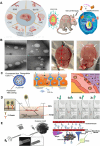Nanorobots mediated drug delivery for brain cancer active targeting and controllable therapeutics
- PMID: 39542942
- PMCID: PMC11564721
- DOI: 10.1186/s11671-024-04131-4
Nanorobots mediated drug delivery for brain cancer active targeting and controllable therapeutics
Abstract
Brain cancer pose significant life-threats by destructively invading normal brain tissues, causing dysneuria, disability and death, and its therapeutics is limited by underdosage and toxicity lying in conventional drug delivery that relied on passive delivery. The application of nanorobots-based drug delivery systems is an emerging field that holds great potential for brain cancer active targeting and controllable treatment. The ability of nanorobots to encapsulate, transport, and supply therapies directly to the lesion site through blood-brain barriers makes it possible to deliver drugs to hard-to-reach areas. In order to improve the efficiency of drug delivery and problems such as precision and sustained release, nanorobots are effectively realized by converting other forms of energy into propulsion and motion, which are considered as high-efficiency methods for drug delivery. In this article, we described recent advances in the treatment of brain cancer with nanorobots mainly from three aspects: firstly, the development history and characteristics of nanorobots are reviewed; secondly, recent research progress of nanorobots in brain cancer is comprehensively investigated, like the driving mode and mechanism of nanorobots are described; thirdly, the potential translation of nanorobotics for brain diseases is discussed and the challenges and opportunities for future research are outlined.
Keywords: Active targeting; Brain cancer; Controllable therapeutics; Precise oncology; Targeted drug delivery nanorobots.
© 2024. The Author(s).
Conflict of interest statement
Figures









Similar articles
-
Recent progress in magnetic applications for micro- and nanorobots.Beilstein J Nanotechnol. 2021 Jul 19;12:744-755. doi: 10.3762/bjnano.12.58. eCollection 2021. Beilstein J Nanotechnol. 2021. PMID: 34367858 Free PMC article. Review.
-
Biocompatible smart micro/nanorobots for active gastrointestinal tract drug delivery.Expert Opin Drug Deliv. 2023 Jul-Dec;20(10):1427-1441. doi: 10.1080/17425247.2023.2270915. Epub 2023 Oct 30. Expert Opin Drug Deliv. 2023. PMID: 37840310 Review.
-
Micro/Nanorobot: A Promising Targeted Drug Delivery System.Pharmaceutics. 2020 Jul 15;12(7):665. doi: 10.3390/pharmaceutics12070665. Pharmaceutics. 2020. PMID: 32679772 Free PMC article. Review.
-
Micro/nanorobots for precise drug delivery via targeted transport and triggered release: A review.Int J Pharm. 2022 Mar 25;616:121551. doi: 10.1016/j.ijpharm.2022.121551. Epub 2022 Feb 5. Int J Pharm. 2022. PMID: 35131352 Review.
-
Micro and nanorobot-based drug delivery: an overview.J Drug Target. 2022 Apr;30(4):349-358. doi: 10.1080/1061186X.2021.1999962. Epub 2021 Nov 9. J Drug Target. 2022. PMID: 34706620 Review.
Cited by
-
Advances in nanorobotics for gastrointestinal surgery: a new frontier in precision medicine and minimally invasive therapeutics.J Robot Surg. 2025 Jul 14;19(1):390. doi: 10.1007/s11701-025-02550-8. J Robot Surg. 2025. PMID: 40660043 Review.
-
The role of nanomedicine and artificial intelligence in cancer health care: individual applications and emerging integrations-a narrative review.Discov Oncol. 2025 May 8;16(1):697. doi: 10.1007/s12672-025-02469-4. Discov Oncol. 2025. PMID: 40338421 Free PMC article. Review.
-
Nanomedicine: a cost-effective and powerful platform for managing neurodegenerative diseases.Metab Brain Dis. 2025 Mar 11;40(3):142. doi: 10.1007/s11011-025-01564-3. Metab Brain Dis. 2025. PMID: 40067468 Review.
-
Harnessing immunotherapy: cancer vaccines as novel therapeutic strategies for brain tumor.Front Immunol. 2025 Jul 17;16:1588081. doi: 10.3389/fimmu.2025.1588081. eCollection 2025. Front Immunol. 2025. PMID: 40746549 Free PMC article. Review.
-
Nanotherapeutics for Meningitis: Enhancing Drug Delivery Across the Blood-Brain Barrier.Biomimetics (Basel). 2025 Jan 3;10(1):25. doi: 10.3390/biomimetics10010025. Biomimetics (Basel). 2025. PMID: 39851741 Free PMC article. Review.
References
-
- Miller KD, Ostrom QT, Kruchko C, Patil N, Tihan T, Cioffi G, Fuchs HE, Waite KA, Jemal A, Siegel RL, Barnholtz-Sloan JS. Brain and other central nervous system tumor statistics, 2021. CA Cancer J Clin. 2021;71(5):381–406. - PubMed
-
- Wang J, Dong Y, Ma P, Wang Y, Zhang F, Cai B, Chen P, Liu BF. Intelligent micro-/nanorobots for cancer theragnostic. Adv Mater. 2022;34(52):2201051. - PubMed
Publication types
Grants and funding
- 28709-312200502501/Start-Up Fund for Introduced Talents and Scientific Research at Beijing Normal University
- A20231006/Hospital-level scientific research fund of Yunfu People's Hospital
- 2021ZD0204300/National Major Projects in Brain Science and Brain-Like Research
- 2021ZD0204300/National Major Projects in Brain Science and Brain-Like Research
- FDCT 0020/2019/AMJ and FDCT 0011/2018/A1/Fundo para o Desenvolvimento das Ciências e da Tecnologia
LinkOut - more resources
Full Text Sources
